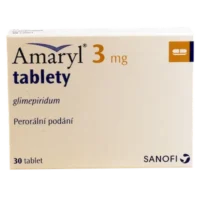Description
Glimepirid-TEVA Tablets 3 mg. №30
Composition:
Each tablet contains 3 mg of Glimepiride.
Mechanism of Action:
Glimepiride, a sulfonylurea, increases insulin release from the pancreas, leading to decreased blood sugar levels.
Pharmacological Properties:
Glimepirid-TEVA tablets belong to the sulfonylurea class of antidiabetic agents, promoting insulin secretion and improving glucose utilization in the body.
Indications for Use:
Glimepirid-TEVA tablets are specifically indicated for the treatment of type 2 diabetes mellitus.
Contraindications:
Avoid the use of Glimepirid-TEVA tablets in patients with type 1 diabetes or diabetic ketoacidosis due to potential adverse effects.
Side Effects:
Common side effects may include hypoglycemia, gastrointestinal disturbances, and allergic reactions. Monitor for any unusual symptoms and seek medical advice if necessary.
Usage Instructions:
Administer Glimepirid-TEVA tablets as prescribed by a healthcare professional, typically once daily with a meal to optimize efficacy.
Benefits Compared to Analogues:
Glimepiride has demonstrated effectiveness in improving glycemic control and reducing HbA1c levels, showing favorable outcomes compared to other antidiabetic agents.
Suitable Patient Groups:
Glimepirid-TEVA tablets are suitable for adult patients with type 2 diabetes, including the elderly population, but not recommended for children without medical supervision.
Storage and Shelf Life:
Store Glimepirid-TEVA tablets in a cool, dry place away from direct sunlight. Check the expiration date on the packaging and do not use expired medication.
Packaging Description:
Glimepirid-TEVA tablets are packaged in blister packs containing 30 tablets each, ensuring convenient and accurate dosing.
Clinical Evidence and Effectiveness:
Research in the Journal of Diabetes Investigation has highlighted the efficacy of Glimepiride in enhancing glycemic control and overall glucose management in patients with type 2 diabetes. Clinical trials have consistently shown positive outcomes with the use of Glimepirid-TEVA tablets.





